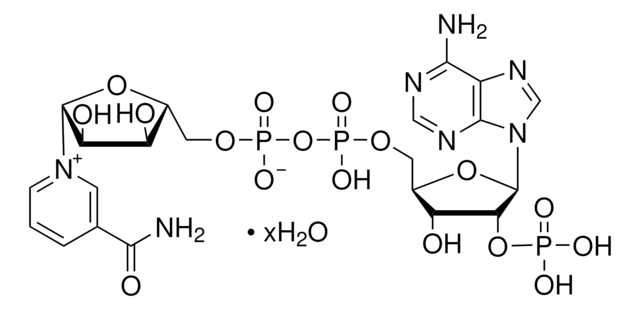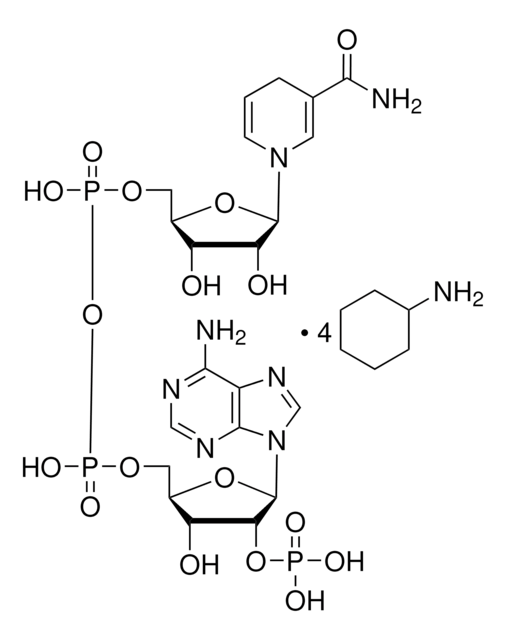N7505
β-Nicotinamidadenin-dinucleotidphosphat-2′-Phosphat, reduziert Tetranatriumsalz
≥97% (HPLC)
Synonym(e):
β-NADPH, 2′-NADPH Hydrat, Coenzym II reduziert Tetranatriumsalz, Dihydronicotinamidadenin-dinucleotidphosphat Tetranatriumsalz, NADPH Na4, TPNH2 Na4
About This Item
Empfohlene Produkte
Biologische Quelle
chicken
Qualitätsniveau
Assay
≥97% (HPLC)
≥97% (spectrophotometric assay)
Form
powder
Löslichkeit
10 mM NaOH: soluble 50 mg/mL, clear
Lagertemp.
−20°C
SMILES String
[Na+].[Na+].[Na+].[Na+].NC(=O)C1=CN(C=CC1)[C@H]2O[C@@H](COP([O-])(=O)OP([O-])(=O)OC[C@H]3O[C@H]([C@H](OP([O-])([O-])=O)[C@@H]3O)n4cnc5c(N)ncnc45)[C@H](O)[C@@H]2O
InChI
1S/C21H30N7O17P3.4Na/c22-17-12-19(25-7-24-17)28(8-26-12)21-16(44-46(33,34)35)14(30)11(43-21)6-41-48(38,39)45-47(36,37)40-5-10-13(29)15(31)20(42-10)27-3-1-2-9(4-27)18(23)32;;;;/h1,3-4,7-8,10-11,13-16,20-21,29-31H,2,5-6H2,(H2,23,32)(H,36,37)(H,38,39)(H2,22,24,25)(H2,33,34,35);;;;/q;4*+1/p-4/t10-,11+,13-,14+,15-,16+,20-,21+;;;;/m0..../s1
InChIKey
WYWWVJHQDVCHKF-MPUNMZHWSA-J
Suchen Sie nach ähnlichen Produkten? Aufrufen Leitfaden zum Produktvergleich
Biochem./physiol. Wirkung
Angaben zur Herstellung
Sonstige Hinweise
auch häufig zusammen mit diesem Produkt gekauft
Lagerklassenschlüssel
11 - Combustible Solids
WGK
WGK 1
Flammpunkt (°F)
Not applicable
Flammpunkt (°C)
Not applicable
Persönliche Schutzausrüstung
Eyeshields, Gloves, type N95 (US)
Analysenzertifikate (COA)
Suchen Sie nach Analysenzertifikate (COA), indem Sie die Lot-/Chargennummer des Produkts eingeben. Lot- und Chargennummern sind auf dem Produktetikett hinter den Wörtern ‘Lot’ oder ‘Batch’ (Lot oder Charge) zu finden.
Besitzen Sie dieses Produkt bereits?
In der Dokumentenbibliothek finden Sie die Dokumentation zu den Produkten, die Sie kürzlich erworben haben.
Kunden haben sich ebenfalls angesehen
Artikel
Neoplastic cells are highly dependent on the de novo synthesis of nucleotides to maintain sufficient pools to support DNA replication and the production of RNA.
Information on fatty acid synthesis and metabolism in cancer cells. Learn how proliferatively active cells require fatty acids for functions such as membrane generation, protein modification, and bioenergetic requirements. These fatty acids are derived either from dietary sources or are synthesized by the cell.
Unser Team von Wissenschaftlern verfügt über Erfahrung in allen Forschungsbereichen einschließlich Life Science, Materialwissenschaften, chemischer Synthese, Chromatographie, Analytik und vielen mehr..
Setzen Sie sich mit dem technischen Dienst in Verbindung.








